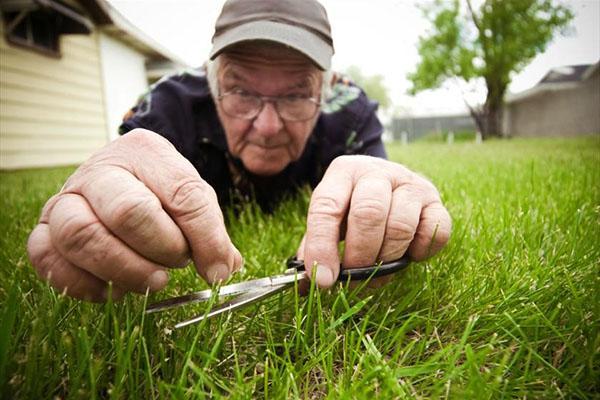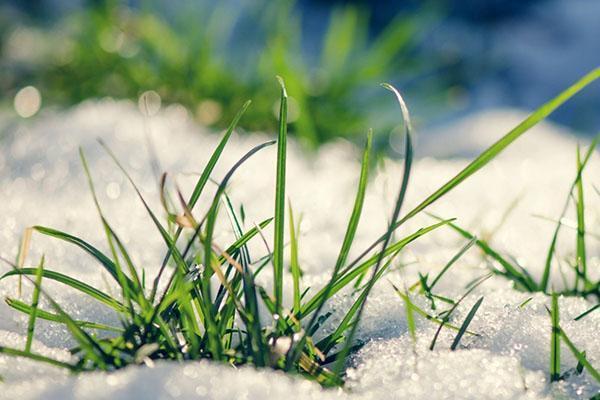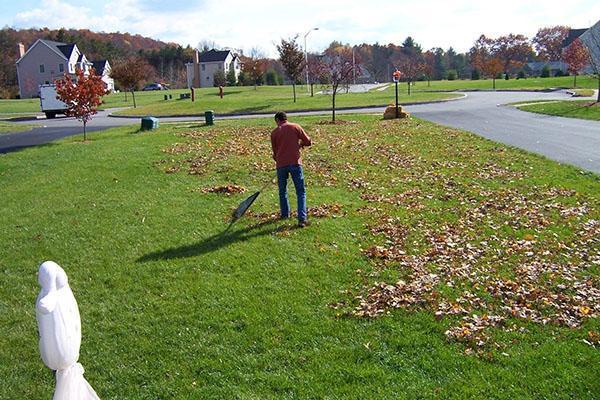Year-round lawn care at their summer cottage
 Neat green lawns are a magnificent decoration of the site, a bright background for ornamental crops, a blooming garden and a cozy home. But only regular, competent lawn care can turn the territory overgrown with grass into an owner's pride.
Neat green lawns are a magnificent decoration of the site, a bright background for ornamental crops, a blooming garden and a cozy home. But only regular, competent lawn care can turn the territory overgrown with grass into an owner's pride.
Many inexperienced summer residents believe that by arranging a lawn on the site, you can save effort, quickly transform the surrounding space and not think about independently growing cereals for several years. But in reality, the lawn requires constant attention. The first exit to the lawn must be done as soon as the snow melts, and the lawn care is completed in the fall, a couple of weeks before the snow cover is established. And yet, you should not be afraid of difficulties.
If the grass is regularly looked after, and all the planned procedures are performed on time, then the lawn really pleases the eyes for many years, and taking care of it brings only pleasure.
How to care for the lawn in the country? What are the features of work on the lawn in different seasons of the year, and how to properly distribute the efforts?
Features of lawn care after winter

The fact is that the snow and ice that compacts in the spring hinder the penetration of air to the waking grass. Moisture can build up under the ice crust. As a result, the root system of plants suffers, the remaining leaves can rot. The gardener's task is to gently break the ice, remove accumulations of packed snow.
Brushing and cleaning the lawn
 When the snow melts and the ground dries up a little, the grass cover should be cleaned of the remnants of last year's grass. Blades of grass that have died out during the fall and winter under the snow settle to the ground and crumble, forming a kind of gray-brown felt. If such plant debris is not removed, it is:
When the snow melts and the ground dries up a little, the grass cover should be cleaned of the remnants of last year's grass. Blades of grass that have died out during the fall and winter under the snow settle to the ground and crumble, forming a kind of gray-brown felt. If such plant debris is not removed, it is:
- hinder the germination of young grass;
- stimulates the development of putrefactive processes and the dispersal of pests;
- will reduce the density of the grass cover, and the lawn will eventually lose its even green color.
You can comb out the lawn with a fan rake, which, due to the design, does not penetrate as deep into the ground as usual. Such maintenance of the lawn in the spring will help to clean the cover from both plant debris and accidental debris accumulated during the cold season.
The procedure is carried out in the longitudinal and then in the lateral direction so that the first stage of lawn care after winter affects all its areas.
Aeration for lawn care in spring and autumn
 The roots of the perennial grasses used to plant the lawn quickly form a sod so dense that it can be compared to a rough and very strong burlap.
The roots of the perennial grasses used to plant the lawn quickly form a sod so dense that it can be compared to a rough and very strong burlap.
Therefore, in the spring, when the soil is watered with water, the growth of grass is activated, it is important to help the plants and provide them with air. For this purpose, aeration lawns. The lawn care procedure consists of piercing the coating. Point punctures with a depth of 8 to 10 cm are made at a short distance from each other over the entire coverage area.
Such holes:
- help oxygen to penetrate deep into the soil;
- stimulate the activity of beneficial soil microorganisms;
- prevents the development of putrefactive fungi and bacteria;
- prevent waterlogging of the substrate;
- provide root respiration;
- accelerate the renewal of the grass cover after winter.
 If the area under the grass is small, a conventional pitchfork will help to cope with aeration.
If the area under the grass is small, a conventional pitchfork will help to cope with aeration.
With extensive lawns, aeration after winter care requires mechanization. Gasoline or electric aerators will be useful here, which both speed up the work and simplify it many times over.
Re-aeration is carried out closer to autumn. In summer, especially on hot days, such a lawn care procedure is not carried out.
Mowing: the main task of lawn care in spring and summer
 If the lawn is not mowed, the grains will grow and the surface will lose its evenness. Therefore, mowing is the main measure for lawn care. It is carried out from spring to mid-autumn, when it is time to prepare the coating for "hibernation".
If the lawn is not mowed, the grains will grow and the surface will lose its evenness. Therefore, mowing is the main measure for lawn care. It is carried out from spring to mid-autumn, when it is time to prepare the coating for "hibernation".
The main purpose of mowing, as a stage of lawn care in spring and summer, is to make the lawn look neat and attractive. For any lawn area, its owner cannot do without high-quality lawn mowers or at least a trimmer, otherwise it is almost impossible to get an even grass cover of the same height.
Mowing the grass is preceded by cleaning the lawn. This measure is needed not only to remove debris that could damage the lawn mower mechanism, but also to straighten the grass. The lawn is mowed on sunny, cool days. The grass must be dry, otherwise the blade of grass sticks to the knives and damage to the mechanization equipment.
As part of regular lawn care in summer, mowing is carried out as the leaf plates grow back. The frequency depends on the weather conditions and the plant chosen for sowing.
 Most often, the interval between mowing is from 2 to 4 weeks, but wanting to delay the next procedure, some gardeners try to cut the grass lower. This is a dangerous mistake. Mowing in this way greatly weakens the lawn, depriving plants of important nutrition through photosynthesis. It is better if the grass cover maintains a height of 7–9 cm from the ground level.
Most often, the interval between mowing is from 2 to 4 weeks, but wanting to delay the next procedure, some gardeners try to cut the grass lower. This is a dangerous mistake. Mowing in this way greatly weakens the lawn, depriving plants of important nutrition through photosynthesis. It is better if the grass cover maintains a height of 7–9 cm from the ground level.
Lawn mowing is carried out in two stages. First, the area covered with grass is traversed in one direction. The second processing is carried out perpendicular to the original.
Top dressing of the lawn in spring and autumn as part of lawn care
 Spring lawn care in the country is not limited to mowing, aeration and timely cleaning. Frequent mowing, causing intensive grass growth, invariably leads to weakening of plants and depletion of soil reserves of nutrients and trace elements.
Spring lawn care in the country is not limited to mowing, aeration and timely cleaning. Frequent mowing, causing intensive grass growth, invariably leads to weakening of plants and depletion of soil reserves of nutrients and trace elements.
Therefore, top dressing is the most important part of lawn care in spring, summer and autumn. Fertilization is carried out after cutting and must be accompanied by abundant watering of the plants. The frequency of fertilization depends on the condition of the plants. The interval between dressings varies from 4 to 6 weeks, and the first procedure is carried out immediately after the complete disappearance of the snow, and the last one - two weeks before the onset of cold weather.
 Lawn care in autumn is different from spring. If during active vegetation the grass needs more nitrogen, then by winter it is limited in this element, replacing it with potassium and phosphorus. To simplify the care of the lawn in the country, experts recommend using complex formulations that fully meet the requirements of cereals at different times of the year.
Lawn care in autumn is different from spring. If during active vegetation the grass needs more nitrogen, then by winter it is limited in this element, replacing it with potassium and phosphorus. To simplify the care of the lawn in the country, experts recommend using complex formulations that fully meet the requirements of cereals at different times of the year.
Fertilizers are applied dry by hand or using a special device, or the plants are fed with liquid agents, including them in the irrigation scheme.
In addition to fertilizing, in the spring and in the summer, weeds and fungi that often populate green lawns are controlled. If sometimes it is possible to cope with weed shoots manually, then only the mycelium will be removed from the site herbicides and systemic fungicides produced specifically for use in the care of country lawns.
Watering the country lawn: leaving the warm season
 The lawn needs moisture throughout the warm season, while the grass grows and receives nutrition from the soil. In the middle lane, you can water the lawn 2-3 times a week, but sometimes the weather makes its own adjustments to the schedule:
The lawn needs moisture throughout the warm season, while the grass grows and receives nutrition from the soil. In the middle lane, you can water the lawn 2-3 times a week, but sometimes the weather makes its own adjustments to the schedule:
- in the rainy period, watering is reduced or stopped completely.
- in dry times, the amount of irrigation water is increased, but the procedure is never carried out at noon, when the sun is most active.
Due to the risk of damage to the superficial root system of the grasses, the lawns should never be watered with a hose.
All sorts of irrigation systems, providing for cutting the water flow or using the drip method. To meet the needs of the lawn, the soaking depth must reach 15–20 cm, otherwise part of the root system ends up in dry soil and the grass does not receive proper nutrition.
Mulching: Part of Falling Lawn Care
 Spring maintenance of the lawn determines its future growth and beauty. Measures taken in the fall help keep the grass healthy until next season.
Spring maintenance of the lawn determines its future growth and beauty. Measures taken in the fall help keep the grass healthy until next season.
From September to mid-October, lawn owners begin preparing their lawn for wintering. An important element of lawn care at this time is soil mulching. The procedure consists in evenly scattering a mixture of their peat, sand and humus on the site, which helps:
- increase the thickness of the nutrient layer of the soil;
- improve the growth and renewal of the root system;
- stimulate the growth of grass;
- level the lawn next year.
You need to take care of the lawn all year round. Only such a systematic approach will ensure the stable long quality of the grass cover, its beauty and uniform density.